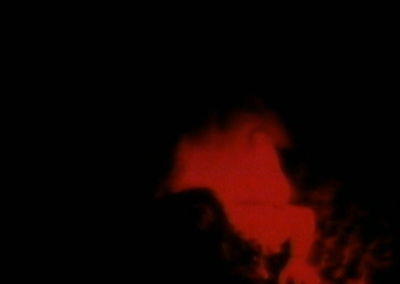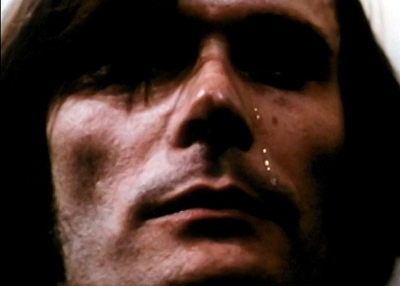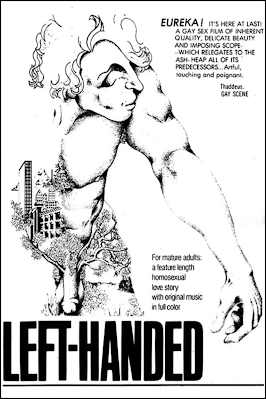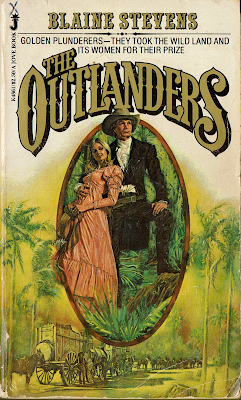I’ve been so busy
at work and bogged down in the never-ending nightmare of getting work done on
our house (as I write this the interior of our home is draped in plastic
sheeting, like we’re aspiring serial killers) that I almost let May slip by
without posting anything. And I still might (I write slow), but I want to at
least
try to post something new before June.
So, let’s watch
some classic gay porn!
Director Jack Deveau’s 1972 debut LEFT-HANDED, co-directed by Jaap Penraat (no, not the World War II resistance fighter) not only gets
singled out as one of the first scripted gay porn films with an original musical score, but it’s lauded as
much for its artfulness as it is for its eroticism. While I appreciate all those
things, what drew me to the movie was its star, Ray Frank. The moment I saw Ray
Frank’s photo on the cover of the Bijou Video DVD of Left-Handed—his
hair damp from the shower, his body like a Greek sculpture if Greek sculptors
were into man-sized penises, and wearing an expression that lets it be known that he’s
just been fucked and ready to be fucked again—was the moment I knew I had
to see this movie despite some initial reservations, which we’ll get to later.
When we meet Ray,
he’s walking down a New York City street, wearing a Canadian tuxedo like it’s
fetish wear. I swear his pants have been specially tailored to accentuate his
crotch and ass. Ray covers a lot of ground in his post-credits walk, so it’s understandable he’d have to stop at a men’s room to drain the lizard at some point. While he takes a leak, we get a sampling of the graffiti adorning the walls, from jokey (“Please don’t throw toothpicks in the toilet—crabs pole vault”) to the usual offers of blow jobs with numbers for interested parties to call. Other people are advertising more specific needs: “I want to meat [sic] a young boy with a huge cock to fuck my ass and eat my cock who I can beat with a big wip [sic] and cat of nine tail [sic] and make bleed and cry and come in my mouth as I shoot off in my wife’s mouth.” (So, does he mean boy as in “young man” or as in “icky and illegal”? And is his wife just sitting around waiting until her husband is ready to nut? Maybe she could enter this harrowing scene as a cruel school mistress, taking that cat o’ nine tails to her husband every time he misspells a word, which will most definitely leave him bleeding and crying.)
 |
| Elton-Carvey is ready for another round! |
The graffiti that piques
Ray’s interest is a drawing of a large dick pointing at the last stall, with the
accompanying plea to “lick my hot cock.” He opens the stall door to discover a
bespectacled dude idly beating off, just waiting for someone to follow the dick
drawing to his toilet stall lair. This might be more inviting if the man in the
stall didn’t look like a cross between a young Dana Carvey and a young, de-glammed
Elton John, neither of whom inspire instant lust. But Ray is clearly not focused
on this tearoom queen’s face—the camera certainly isn’t—when he joins him in
the stall and, as instructed by the graffiti outside, licks his hot cock, as
well as sucks it.
Meanwhile, Woodstock-based
drug dealer Bob (Robert Rikas), goes into the city to make a delivery. His
client is Larry (Larry Burns), who owns an antiques store in NYC and sells pot
on the side, or, more likely, the antiques store is just a front for his drug
dealing as Larry seems to have zero interest in his antiques business.
 |
| This is Larry, hard at work. |
It turns out that
Larry’s antiques store is also Ray’s ultimate destination. He’s hoping to find
a good deal on a Queen Anne tea table. OK, I’m kidding, he’s there to score
some weed. Ray arrives at the shop about the time Larry and Bob are concluding
their deal, and it’s lust at first sight. (One of the sights Ray sees is Bob
lifting his sweater to stick his payment into the waist of his jeans, because
sticking the money in his pocket like a normal person would deny Ray—and the viewer—a
glimpse of Bob’s rippling abs.) Larry tells Bob to say hello to his girl for him.
“What a waste,” Larry laments once Bob’s out the door. “That’s one we’ll never
get.”
“Maybe you can’t
get him. I bet I could,” replies Ray.
All this thirst for
Bob might seem a bit mystifying if your only frame of reference is his
unflattering photo on the cover of the Bijou DVD, on which he looks
like Crispin Glover as an anthropomorphic steam shovel. However, Ray is more
appealing in the movie proper, resembling a young Viggo Mortensen. Also, he’s got
a rockin’ bod.
 |
There’s no escaping straight people,
even in gay porn. |
Perhaps to hammer
home the challenge Ray faces in seducing the hunky dealer, we get a scene of heterosexual
humping (not an uncommon occurrence in ’70s gay porn;
Navy Blue and
Passing
Strangers, to name but a couple, also feature scenes of hetero fucking). I’m
sure there will be queer viewers who will find this sequence unnecessary/repellant—the
same ones who let out a horrified shriek whenever a woman doffs her top at
Pride—but the camera is primarily focused on Bob’s body, which, again, is quite
nice. His girlfriend (played by Cindy West) could just as easily have been a Fleshlight
with a wig glued on top. At the end of the scene, as Bob’s unnamed girlfriend sucks him
off, she suddenly declares in a voice over that “you’re all a bunch of bastards”
because... he came in her mouth, maybe? It’s never explained.
We then join Ray
back at his loft, where he strips down to a pair of fishnet briefs, lies back on
his bed and rubs one out fantasizing about Larry, never mind that fantasizing
about Bob makes more narrative sense. It’s still a hot scene, the fantasy
action shot in black and white while Ray’s stroke session is captured in glorious,
grainy color. Robert Alvarez, Left-Handed’s editor who co-founded
Hand-in-Hand Films with his partner Deveau, said in an interview on the
Bijou
Blog that this sequence was meant to be a reverse of The Wizard of Oz. “I really loved the idea of creating a piece, a sex scene that had some
rhythm to it and some sense of movies, of real movies, you know?” says Alavarez.
 |
| Ray enjoys some personal time. |
 |
Bob suddenly accepts the fluidity of human
sexuality. |
Later—the next day,
next week, next year, who knows—Ray and Bob meet up and head back to Ray’s place to smoke
a couple joints (in stars-and-stripes rolling papers, no less). As the evening
wears on Bob’s straightness begins to wear down. Next thing we know, the staunchly
hetero Bob is tentatively reaching for Ray’s crotch, because no one is that straight.
Ray drowsily rolls into Bob’s arms for a kiss. The camera then backs up into a
wide shot to capture them naked and making slow, sensual love. They later hop
in the shower for an energetic fuck.
This no one night
stand but the beginning of an affair, with Ray spending weekends up at Bob’s
place in Woodstock. Seems awkward, given that Bob lives with his girlfriend,
but she seems content to just hang around the house, smoking cigarettes and
staring pensively into the distance while Bob and Ray go off to the barn for a
quick B.J., or to make out by a creek. Though we never get to see a direct confrontation
between Bob and his girlfriend, we can tell by her body language that she’s not
happy. Later, Ray tells Larry that Bob’s GF won’t be around much longer. She’s
definitely not around when Ray spends another weekend with Bob, the two men doing
’shrooms before doing each other. Deveau and Penraat earn points for not
resorting to the usual camera tricks used to portray onscreen drug trips—fly vision,
fisheye lenses, kaleidoscope effects—but they still manage to find a filter
that robs the scene of its erotic impact by making the action look like an
animated Rorschach test.
 |
| Hot? |
Alas, the high can’t
last forever, with the beginning of the end signaled by Ray telling Larry that
he’s ready for a change. Ray then makes the tragic decision to shave his beard.
 |
| Noooooo! |
 |
| Becoming Al Pacino. |
Ray Frank is an
attractive guy with or without facial hair, but personally speaking, I found
him 35% sexier with a beard. Ray’s decision to shave coincides with Larry’s
invitation to attend a little orgy that he’s hosting, starting promptly at 8
p.m. This orgy also presents another argument against Ray shaving his beard: most
of the orgy attendees are also dark-haired, clean-shaven men with slight,
muscular builds (diversity is not one of the movie’s selling points), so Ray
gets lost in the pile. Larry, another bearded dude, and a guy who kind of resembles
Barry Gibb if you squint, end up being the only distinctive performers. This
makes the final minutes of the film, when Bob—invited to show up at eleven,
after all loads have been spilled—appears at the door and discovers his
boyfriend is a cheating bastard, a lot less impactful since Ray blends in with
the crowd.
 |
| Or maybe Bob’s just sad that Ray shaved his beard. |
It should also be mentioned
that this final orgy scene includes a fisting sequence, something I
could’ve done without, personally (it makes me think of
animal husbandry, but that’s just me). In fact, that is why I was initially wary of seeing this movie,
because I was sure its title alluded to there being a whole bunch of handballing
going on. (Had
Left-Handed been directed by Joe Gage I’d just assume
it would be all about masturbation.) But the fisting in
Left-Handed
is not only brief but executed far more gently than is usually seen in gay porn
(it’s all hearts and flowers compared to the PTSD-inducing anal assault seen in
Fred Halsted’s
Sextool.) More viewers will likely be put off by the
scene’s boner-killing jazz rock score.
Grittier than Boys in the Sand, yet Weirdly More Romantic
 |
| Ray gives Bob a hand. |
Left-Handed was released
shortly after Wakefield Poole’s
Boys in the Sand, and while it’s not quite
as polished a movie, it’s no less effective. In fact, I’d argue that it’s more
effective than
Sand.
Sand is pretty to look at, and the sex is fairly
hot, but it’s strictly fantasy, while
Left-Handed’s gritty style and story
arc, simplistic thought it may be, make it more involving. Consequently, though
Sand
has the more romanticized presentation of gay sex, it’s the grungy looking
Left-Handed
that’s the more romantic movie, the fisting notwithstanding. It even features a
couple ballads worthy of any second-rate Vegas crooner’s set list.
As much as I
enjoyed this movie, and really think it’s hot, I realize it’s a tough sell
to present-day audiences. Even if you’re cool with the scraggly hippie look and
aren’t turned off by the early ’70s fashions (they are a hoot, but the guys usually
aren’t dressed very long for them to be a distraction), the sex scenes will likely
not appeal to current sensibilities. For that reason,
Left-Handed is best
approached as a movie to be watched in its entirety, rather than a mere
masturbation aid. The sex scenes are plentiful, but usually last for only 5-10
minutes, and the acts aren’t always captured in explicit detail, a fact that
Alvarez acknowledges: “
Our [movies] were more like—at least I felt,
and Jack felt—to capture the sensuality of the sex or the dynamics of a sex
scene, and whatever shot said that the best is the shot that we used. So, we
didn’t go in for, like, where you can see every pubic hair, you know?” I
didn’t think Deveau’s approach is any less powerful, though I will admit there
were a couple scenes—the tearoom blowjob; Ray and Bob in the barn—that could’ve
benefited from better lighting.
Above all, what
really makes
Left-Handed worth a watch are the two lead performers, Ray
Frank and Robert Rikas. When so many current porn videos look like endurance
tests, it’s nice to see performers who
 |
| What’re you looking at? |
appear to actually
enjoy sex. Frank
is the more dynamic performer, as well as the more charismatic presence, though
Rikas proves to be more sensual than his stone-faced expression would have you
believe. Yet, despite being such a natural, it was Frank who bowed out of the
industry after two movies, his only other credit being in Deveau’s follow-up
feature,
Drive, while Rikas went on to appear in several more movies,
his last IMDb credit being 1976’s
Fetishes of Monique. Unfortunately, I couldn’t
find anything else out about either performer. Alvarez wasn’t any more
enlightening about the
Left-Handed’s two leads when asked about them by Bijou:
“
[Jack Deveau] used to put out casting calls. And, I think, we
knew the guy who played the lead. We knew both of them. And so, they agreed to
be in it.” Considering how often I’m disappointed when I
learn more about performers’ personal lives, maybe that’s all I really need to know.























